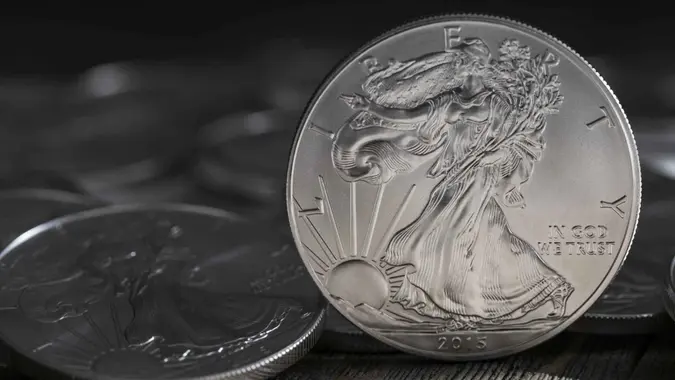Are $50 Bills Worth More Than Face Value? You Could Earn $250 or More on Even an Average Condition Bank Note

Commitment to Our Readers
GOBankingRates' editorial team is committed to bringing you unbiased reviews and information. We use data-driven methodologies to evaluate financial products and services - our reviews and ratings are not influenced by advertisers. You can read more about our editorial guidelines and our products and services review methodology.

20 Years
Helping You Live Richer

Reviewed
by Experts

Trusted by
Millions of Readers
If you have a $50 bill burning a hole in your pocket, you can buy all kinds of cool stuff with it — including a massager, a wooden watch, certain coffee makers, a digital photo frame and a set of hand tools. But if it’s the right $50 bill, you might be able to buy a new car or an addition to your house.
Rare $50 notes issued during the 19th century can fetch tens of thousands of dollars on the collectibles market, according to various auction and collector’s sites. But even more modern $50 bills in wider circulation are worth $250 or more in average condition. A lot depends on when the bill was issued and what kinds of features it has.
As a blog on the Old Money Prices website noted, the first year the U.S. Federal Reserve Bank printed $50 bills was in 1862. These are known as “large size legal tender bills” and hold considerable value today.
The modern version of the $50 bill features Ulysses S. Grant on the front. As of 2019, the bill made up a little more than 3% of all notes printed in the United States, according to the Jacqueline Rare Antique website. Fifty-dollar bills have the second-lowest circulation after the $2 bill.
A guide that accompanied the Old Money Prices blog offered values on $50 bills from 1862 to 1923. Certain 1923 bills, called Porthole notes, have values that range from a few hundred dollars in poor condition to thousands of dollars in very good condition. In some instances, bills with rare serial numbers will make the bills worth a lot more than that.
As with many collectibles, the values of $50 bills are all over the map — from face value ($50) to $20,000 and more.
“In rare instances, we’ve paid over $40,000 for unique national bank note $50 bills,” the Old Money Prices blog stated. “It definitely does happen.”
If you have an old $50 bill lying around, pay close attention to its year, color, condition and serial number. For example, a 1928 Series Gold Seal $50 bill can fetch up to $250 even in average condition, according to Old Money Prices.
Here are some other $50 bills worth $100 or more in average condition:
- 1928 Green Seal: $75-$150
- 1950E Green Seal: $75-$125
- 1929 Brown Seal: $75-$100
Older $50 bills carry a lot more value than that, but good luck finding one. A separate guide on the U.S. Currency Auctions (USCA) website listed prices as high as $65,000 for a rare 1875 $50 bill with a red seal. Notes issued before 1900 routinely fetch thousands of dollars in decent condition.
For notes issued after 1920, the highest value for a $50 bill on the USCA table was up to $1,000 for a 1922 Gold Certificate note.
 Written by
Written by  Edited by
Edited by 

























